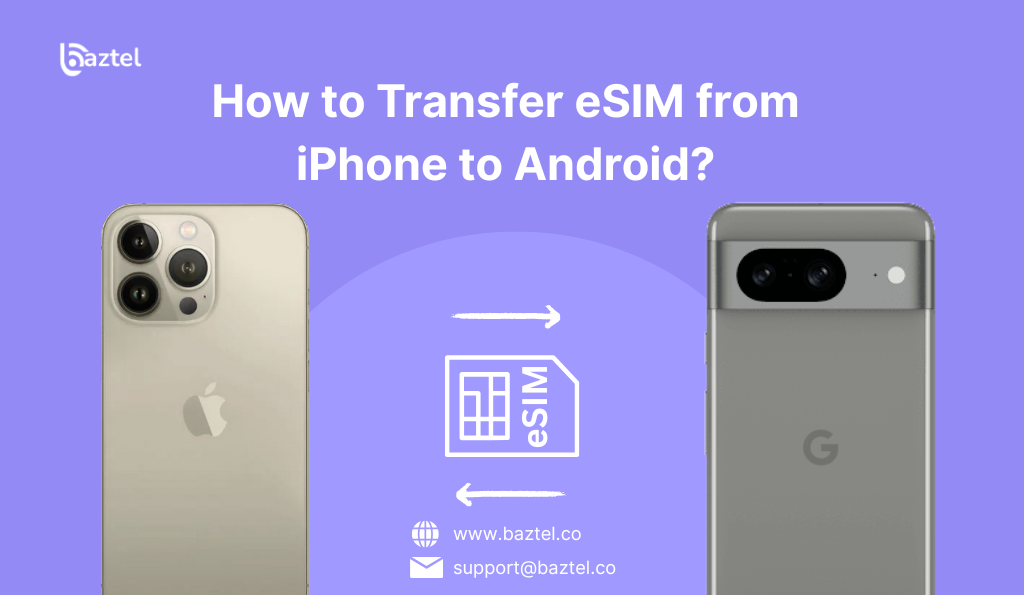Switching from an iPhone to the Android device can be a refreshing change -but can be confusing too before you transfer your eSIM. With different operating systems and carrier settings, it is necessary to understand that the way eSIM is transferred from the iPhone to Android is necessary to keep in touch. Whether you are entering Samsung Galaxy, Google Pixel or any other Android smartphone.
An eSIM, or built -in SIM, is a digital version of the traditional SIM card produced directly into the smartphone. This allows you to activate mobile schemes without inserting a physical card or switch. With eSIM, it is easy to switch between the carriers, the layout is fast, and you can save many profile corrections for subsequent travelers or double-SIM users. It is safer and environmentally friendly, reducing the requirement for plastic strap. Whether you change your phone, travel abroad or just looking for flexibility, ESIM offers a spontaneous and modern mobile connection experience. Success requires some specific stages to succeed in moving esim from iPhone to Android.
To understand what an eSIM is and how it works, check out our post on What is eSIM Card and How Does It Work?.
This blog will help you out to know the process, action -rich steps. We will cover everything more easily to set the supplier as tips, troubleshooting and baztel.co, from not respecting eSIM on the iPhone to putting it on our new Android device.
Can You Transfer eSIM from iPhone to Android?
Yes, you can transfer an eSIM from iPhone to Android, but certain limitations apply. Success depends on carrier support, device compatibility, and whether a new QR code is needed. Most carriers don’t allow direct transfers, so reactivating the eSIM on your new Android phone is usually required.
- Carrier Support
Not every mobile carrier supports transferring an eSIM from iPhone to Android. Some carriers allow platform-specific profiles, meaning you might need a new QR code or plan to switch devices.
- Device Compatibility
Your new Android phone must support eSIM functionality. While many modern devices like Samsung Galaxy and Google Pixel do, some lower-end or older models may not be compatible with eSIM technology.
- Transfer Tools
Apple and Android use different operating systems and eSIM management interfaces. iPhones have built-in transfer options via iOS, while Android often requires manual scanning of a QR code to activate the eSIM.
- QR Code Reusability
Most eSIM QR codes are disposable for safety reasons. If you have already used the code on the iPhone, contact your carrier or vendor for a new Android activation code.
In many cases, you won’t “transfer” the eSIM per se—you’ll reinstall or reactivate the eSIM on the new device using a QR code or manual setup, which we’ll cover in the steps below.
Before You Begin: Pre-Transfer Checklist
To ensure a smooth transition when transferring eSIM from iPhone to Android, here’s a quick checklist:
- Both devices are unlocked and support eSIM
- You’ve backed up your contacts and data
- You have internet access (Wi-Fi recommended)
- Your carrier supports eSIM on both platforms
- You’ve contacted your carrier (if needed) to reissue the eSIM QR code
How to Transfer eSIM from iPhone to Android: Step-by-Step Guide
Let’s walk through the general steps to transfer eSIM from iPhone to Android, including specific notes for Samsung users.
Step 1: Remove eSIM from iPhone
Before transferring, you may need to delete or deactivate the eSIM from your iPhone.
Here’s how:
- Open Settings
- Tap Cellular or Mobile Data
- Select your eSIM plan
- Tap Remove Cellular Plan
Important: This does not cancel your mobile plan—it only removes the eSIM profile from your device. Always check with your carrier before deleting an eSIM.
Step 2: Get a New eSIM Activation Code
Since most carriers do not allow transferring the same QR code across platforms, you’ll likely need a new activation QR code.
What to do:
- Contact your carrier and ask them to generate a new eSIM activation code for your Android device.
- Make sure to inform them that you’re switching from an iPhone to an Android or Samsung device.
Step 3: Set Up eSIM on Your Android or Samsung Phone
The process of setting up an eSIM on Android is straightforward.
For Stock Android (Pixel, OnePlus, etc.):
- Open Settings
- Tap Network & Internet > Mobile Network
- Tap + Add or Add Carrier
- Scan the new QR code provided by your carrier
- Follow the prompts to finish setup
For Samsung Devices:
Wondering how to transfer eSIM from iPhone to Samsung? Here’s the process:
- Open Settings
- Tap Connections > SIM Card Manager
- Tap Add Mobile Plan
- Select Scan QR Code from Service Provider
- Scan the new QR code or enter details manually
Once activated, your eSIM plan will be live on your Samsung device.
Tips for a Smooth eSIM Transfer
Successful transmission of eSIM from iPhone involves scanning only the QR code in Android. To keep both devices nearby to protect your activation details, following some smart practices can help prevent installation problems and ensure a spontaneous transition. These simple, yet important phase switches make sharp, simple and more reliable – especially when working with different platforms and conveyor requirements.
- Keep both phones nearby
During the eSIM transfer, you may need confirmation code or settings from the old iPhone. Closing both devices ensures quick access to the necessary details and helps prevent real-time problems, and reduces the risk of interruption during the activation or migration process.
- Not delete before setup
Avoid removing eSIM from an iPhone before activating the new Android device. Some carriers require ESIM to remain active for authentication during transfer. Premature IT removal can cause activation failure or make you request a new QR code from your vendor.
- Update your software
Make sure your iPhone and Android devices are running the latest software versions. Updated operating systems often fix incorrectly, improve compatibility and fully support eSIM transmission. Running old firmware can cause connection problems or prevent eSIM from activating properly during or after migration.
- Restart after setup
Once you have completed the eSIM activation on your Android phone, you need to restart your device. It updates your network settings using the configuration update and ensures that the ESIM profile is perfectly functional before using data, calls or texts on the new device.
- Save QR code
Always keep backup of the eSIM QR code – either as a screen or printed copy. If you ever need to reset your phone, replace your device, or reinstall the eSIM , the QR code can save time from being easily accessible and prevent unnecessary contact with your vendor.
Common Issues When Transferring eSIM from iPhone to Android
Even with the right stages, the transfer of an esim from the iPhone to Android can present minor problems such as incorrect or profile match. Fortunately, most of these can be determined by restarting the phone, updating the settings or contacting your vendor – using a smooth and successful infection for the new device.
Issue 1: QR Code Not Working
When trying to scan the QR code on your Android device, you may receive an error or nothing happens. This often occurs if the QR code has already been used or expired, or if your phone’s camera isn’t recognizing the code properly.
Contact your carrier or eSIM provider (like Baztel) to request a new QR code. Many providers allow you to regenerate or resend the QR code from your account dashboard. Make sure your Android phone supports eSIM scanning and has a stable internet connection during setup.
Issue 2: eSIM Plan Not Detected
Explanation:After scanning the QR code or entering the activation details, the phone may not detect the mobile plan or fail to add it. This can be due to an incompatible phone, outdated carrier settings, or network issues.
First, restart your Android phone. Then, check if your device is fully updated and supports eSIM for your region and carrier. Also, go to Settings > Network & Internet > Mobile Network and verify that the eSIM is added and active. If not, try re-scanning the QR code or manually entering activation details.
Issue 3: Can’t Delete eSIM on iPhone
You may need to remove the eSIM from your iPhone before activating it on Android, but sometimes the iPhone won’t let you delete it—especially if the device is in Airplane Mode, or if you’re using an outdated iOS version.
Make sure Airplane Mode is turned off, and that your iPhone is connected to the internet. Then go to Settings > Cellular > Your eSIM Plan > Remove Cellular Plan. If this option is grayed out, update your iOS software and try again. You can also contact your carrier to release the eSIM profile remotely.
Issue 4: eSIM Profile Already in Use
If the eSIM has not been fully removed from your iPhone, or if your carrier hasn’t deactivated it, you may see an error that says the profile is already in use when trying to activate it on your Android phone.
Fix
Ensure you’ve completely removed the eSIM from your iPhone. Then restart both devices. If the issue persists, contact your carrier and request that they release or reset the eSIM profile on their end. Some carriers require deactivation before re-provisioning the eSIM to a new device.
Conclusion
Transferring an eSIM from iPhone to Android may seem scary at first, especially with different operating systems and carrying processes. However, with the right steps-such as confirmation of compatibility, manage your QR code safely, and follow transport-specific instructions, you can switch to the devices evenly and without losing the service.
Whether you upgrade to Samsung Galaxy, Google Pixel or any other Android device, the process manufacturers and eSIM support in the mobile network are much easier than before. When smartphones develop, eSIM is a new standard for mobile connection. They do not require enlarged flexibility, fast activation, better protection and physically handle a SIM card – making them perfect for passengers and modern mobile users.
For those looking for a trouble -free infection, you can use a supplier that supports flexible restoration, fast activation and wider international coverage. Some services also allow rapid re-scanning of the QR code or reset of external profiles to ensure that you are never stuck without data, especially when you are at this step.
In short, it is not only possible to move your eSIM – one from the iPhone to Android – this is easier than many expectations. With a little preparation and a reliable supplier, you can enjoy uninterrupted mobile access, even where your journey takes you. So if you are ready to switch and keep in touch with platforms, it’s time to embrace freedom and convenience that modern eSIM solutions offer.
FAQs
- Can I transfer an eSIM directly from iPhone to Android?
No. IOS and Android handle ESIM -are different. You must disable on the iPhone and restore it on Android using a new QR code.
- How do I transfer my ESIM from iPhone to Samsung?
To transfer your eSIM from iPhone to Samsung, request a new QR code from your carrier, and then add it to Settings> Connection> SIM Manager> SIM Manager> Mobile Plan.
- Do I lose my data or number while I transfer eSIM?
No, your phone number and plan continue. Just make sure eSIM is properly activated on the new device.
- What happens if I lose the QR code?
If you use Baztel or any other supplier, you can usually reproduce a QR code via the account table or support.
- Is Baztel compatible with both iPhone and Android?
Yes. Baztel.co eSIM offers plans that work originally in both iOS and Android devices.
Blog Author
Peter
Peter started BazTel.co to make mobile internet easier for travellers. He noticed how tough it was to find good network options while visiting new countries. That’s when he built BazTel — a place where anyone can buy eSIMs online without confusion or long steps. He believes tech should be simple and useful, not complicated. When he’s free, he likes to travel, test BazTel himself, and keep improving it based on real user problems.

 Botswana
Botswana Zambia
Zambia Congo
Congo Colombia
Colombia China mainland
China mainland Chile
Chile Chad
Chad Central African Republic
Central African Republic Canada
Canada Cameroon
Cameroon Cambodia
Cambodia Burkina Faso
Burkina Faso Bulgaria
Bulgaria Brunei Darussalam
Brunei Darussalam Brazil
Brazil Aland Islands
Aland Islands Bosnia and Herzegovina
Bosnia and Herzegovina Bolivia
Bolivia Belgium
Belgium Belarus
Belarus Bangladesh
Bangladesh Bahrain
Bahrain Azerbaijan
Azerbaijan Austria
Austria Australia
Australia Armenia
Armenia Argentina
Argentina Algeria
Algeria



